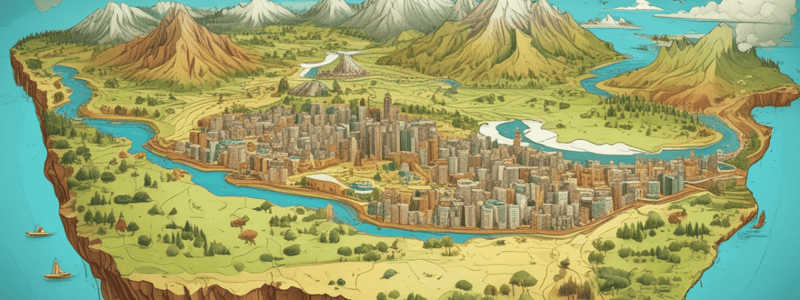Podcast
Questions and Answers
What is the concept of 'place' more closely related to?
What is the concept of 'place' more closely related to?
- The number of people living in a location
- How and where we live (correct)
- The physical location where we live
- The type of house we live in
What is the term for the process of classifying locations based on shared characteristics?
What is the term for the process of classifying locations based on shared characteristics?
- Placelessness
- Localization
- Regionalization (correct)
- Topophilia
What is a characteristic of a formal region?
What is a characteristic of a formal region?
- It is defined by a single cultural trait (correct)
- It is defined by a single physical feature
- It is defined by a single economic activity
- It is defined by a shared perception
What is the term for the visible characteristics of a region?
What is the term for the visible characteristics of a region?
What is the consequence of using multiple cultural traits to define a formal region?
What is the consequence of using multiple cultural traits to define a formal region?
What is an example of a cultural trait that could be used to define a formal region?
What is an example of a cultural trait that could be used to define a formal region?
What is a unique feature of geographic tools in the social sciences?
What is a unique feature of geographic tools in the social sciences?
What is the primary function of maps in geography?
What is the primary function of maps in geography?
What is the purpose of the global grid system?
What is the purpose of the global grid system?
What determines the location of the equator?
What determines the location of the equator?
What is measured in angles from the earth's centre?
What is measured in angles from the earth's centre?
What is latitude?
What is latitude?
What is a line connecting all points along the same latitudinal angle called?
What is a line connecting all points along the same latitudinal angle called?
How many time zones were created in the late 19th century?
How many time zones were created in the late 19th century?
What is the purpose of a map scale?
What is the purpose of a map scale?
What type of map is designed to illustrate patterns or trends?
What type of map is designed to illustrate patterns or trends?
What type of thematic map uses shades or colours to indicate differences in a measurement?
What type of thematic map uses shades or colours to indicate differences in a measurement?
What type of map is used to display a measurement over an area, with differences indicated by the number of dots of identical value?
What type of map is used to display a measurement over an area, with differences indicated by the number of dots of identical value?
What is the main purpose of a map projection?
What is the main purpose of a map projection?
What is the purpose of cartograms?
What is the purpose of cartograms?
What does the shift from one contour line to the next reflect on an isopleth map?
What does the shift from one contour line to the next reflect on an isopleth map?
What type of map is often used to display areas of equal elevation?
What type of map is often used to display areas of equal elevation?
What can be easily seen on an isopleth map?
What can be easily seen on an isopleth map?
What is the primary purpose of cartograms?
What is the primary purpose of cartograms?
What is the term for the technology that measures electromagnetic radiation from a distance?
What is the term for the technology that measures electromagnetic radiation from a distance?
What is the primary application of Geographic Information Systems (GIS)?
What is the primary application of Geographic Information Systems (GIS)?
What is a challenge associated with the use of GPS technology?
What is a challenge associated with the use of GPS technology?
What is a skill that geographers need to develop?
What is a skill that geographers need to develop?
What is a strength of the geography discipline?
What is a strength of the geography discipline?
In Stage 1 of the demographic transition, the crude birth rate (CBR) and crude death rate (CDR) are low.
In Stage 1 of the demographic transition, the crude birth rate (CBR) and crude death rate (CDR) are low.
Every country in the world is currently in Stage 4 of the demographic transition.
Every country in the world is currently in Stage 4 of the demographic transition.
The Gambia is an example of a country in Stage 1 of the demographic transition.
The Gambia is an example of a country in Stage 1 of the demographic transition.
In Stage 3 of the demographic transition, the crude birth rate (CBR) continues to decline, leading to low population growth.
In Stage 3 of the demographic transition, the crude birth rate (CBR) continues to decline, leading to low population growth.
Mexico is an example of a country in Stage 2 of the demographic transition.
Mexico is an example of a country in Stage 2 of the demographic transition.
The National Population Council in Mexico promoted family planning, leading to a decrease in population growth.
The National Population Council in Mexico promoted family planning, leading to a decrease in population growth.
In Stage 4 of the Demographic Transition, Denmark has a high CBR and high CDR.
In Stage 4 of the Demographic Transition, Denmark has a high CBR and high CDR.
Temporary movement is included in the subdiscipline of migration.
Temporary movement is included in the subdiscipline of migration.
The Push-Pull Logic assumes that all people behave according to individual differences.
The Push-Pull Logic assumes that all people behave according to individual differences.
Migration has always led to a decrease in resource base and cultural change.
Migration has always led to a decrease in resource base and cultural change.
The Moorings approach considers the natural environment as a factor in migration.
The Moorings approach considers the natural environment as a factor in migration.
The crude birth rate (CBR) is a better indicator of social well-being than the infant mortality rate (IMR).
The crude birth rate (CBR) is a better indicator of social well-being than the infant mortality rate (IMR).
The total fertility rate (TFR) of 2.1 is considered below the replacement level.
The total fertility rate (TFR) of 2.1 is considered below the replacement level.
Mortality policy generally aims to increase the crude death rate (CDR).
Mortality policy generally aims to increase the crude death rate (CDR).
Fertility policy may lower or raise the total fertility rate (TFR), depending on perceived need.
Fertility policy may lower or raise the total fertility rate (TFR), depending on perceived need.
The population pyramid is a representation of a population's age and sex composition.
The population pyramid is a representation of a population's age and sex composition.
In 2000, people under 14 first outnumbered people over 60.
In 2000, people under 14 first outnumbered people over 60.
The demographic transition model is a descriptive generalization of fertility and mortality change in less developed countries.
The demographic transition model is a descriptive generalization of fertility and mortality change in less developed countries.
The Malthusian theory states that population grows at an arithmetic rate, while food production grows at a geometric rate.
The Malthusian theory states that population grows at an arithmetic rate, while food production grows at a geometric rate.
Population projections show a declining growth rate, but still a positive rate of natural increase.
Population projections show a declining growth rate, but still a positive rate of natural increase.
The rate of natural increase (RNI) is calculated as the crude death rate (CDR) minus the crude birth rate (CBR).
The rate of natural increase (RNI) is calculated as the crude death rate (CDR) minus the crude birth rate (CBR).
The Epidemiological Transition refers to a shift in the prevalence of infectious diseases.
The Epidemiological Transition refers to a shift in the prevalence of infectious diseases.
Health geographies focus on the distribution of disease and poor health.
Health geographies focus on the distribution of disease and poor health.
Environmental contaminants have no impact on health geographies.
Environmental contaminants have no impact on health geographies.
Migration is only affected by demographic factors such as age and marital status.
Migration is only affected by demographic factors such as age and marital status.
Spatial patterns of infectious and degenerative diseases are unaffected by natural environments and social conditions.
Spatial patterns of infectious and degenerative diseases are unaffected by natural environments and social conditions.
The Epidemiological Transition consists of only three stages.
The Epidemiological Transition consists of only three stages.
Health care provision can be provided by only private or public systems.
Health care provision can be provided by only private or public systems.
The world population is decreasing.
The world population is decreasing.
Women in less developed countries are having more children.
Women in less developed countries are having more children.
Government attempts to decrease or increase fertility have had a significant impact.
Government attempts to decrease or increase fertility have had a significant impact.
The distribution of people on earth is random and not the outcome of a long history of migration.
The distribution of people on earth is random and not the outcome of a long history of migration.
Flashcards are hidden until you start studying




